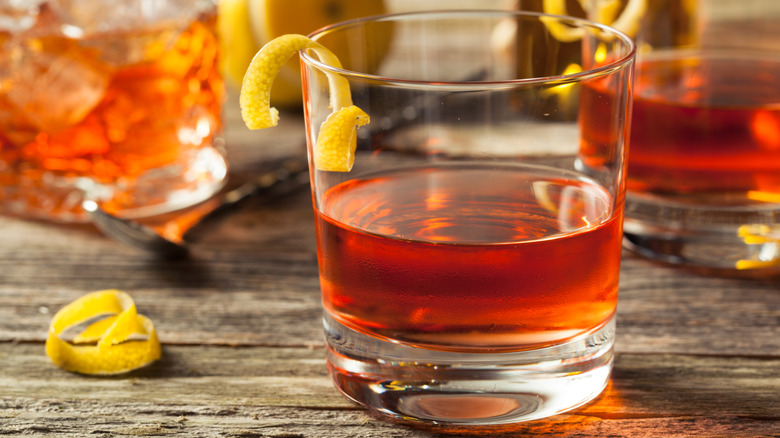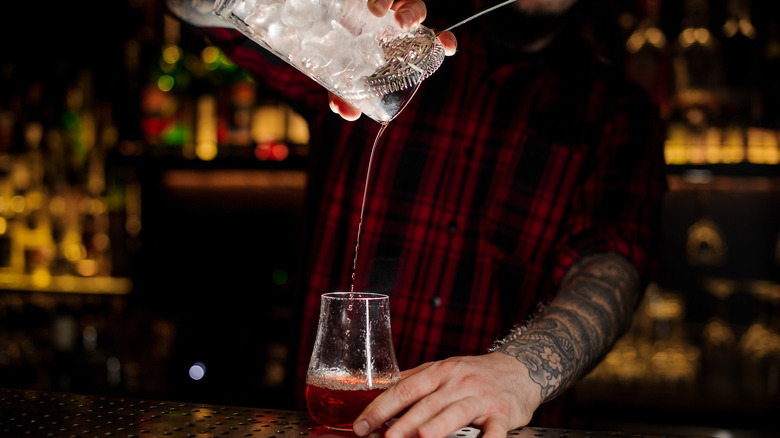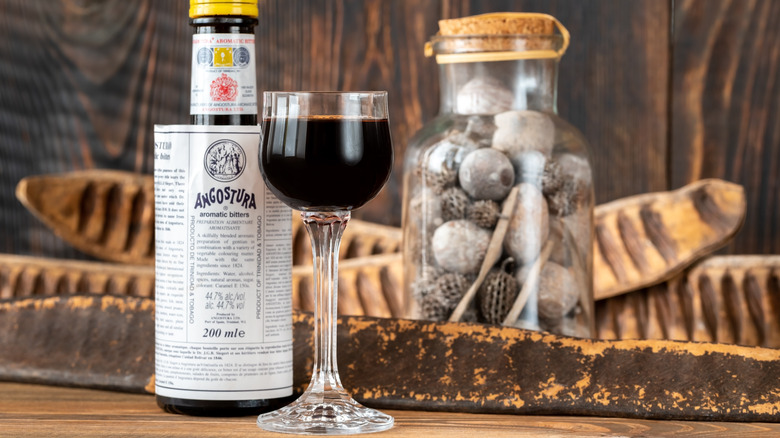A Zazarac Cocktail Isn't A Misspelled Version Of The Iconic Sazerac
If that title brought you back to fifth grade, filled with panic about having to read indecipherable words aloud, then you are in the right place. The origins of cocktails are not always straightforward. Zazarac and Sazerac are distinct concoctions, with features that set them apart. The Sazerac is made with Peychaud's bitters, rye, and no ice, and comes in a glass that's been rinsed with absinthe. The purpose of an absinthe rinse is to provide a subtle infusion of flavor without overpowering the drink. As for the Zazarac, it consists of bourbon, Angostura bitters, and a splash of absinthe, served in a cool but iceless glass.
That's a little too close for comfort and we're curious about the obvious similarities. Is Zazarac just a misspelled cheap knockoff of its cousin the Sazerac? In fact, the Zazarac is just one big spelling mistake that eventually transformed into its own separate cocktail. While it's unclear when the spelling was first confused, it has since stuck. As for the OG Sazerac, it was dubbed New Orleans' official cocktail in 2008 and isn't letting its misspelled cousin slow it down. Admittedly, it kind of sounds like another drink — the old-fashioned. Both feature whiskey, bitters, and sugar, with slight differences like rye and bourbon. It begs us to ask, who is really copying who these days?
Origin of the Sazerac cocktail
The Sazerac cocktail finds its roots in the heart of New Orleans, Louisiana. In its earliest form, the cocktail was meticulously crafted using a specific cognac: Sazerac de Forge et Fils. The narrative deepens with the official establishment of the iconic first Sazerac Coffee House in 1852, according to Kevin Richards, marketing director of the Sazerac Company. It's notable that, around the same time, Antoine Amedée Peychaud was also creating bitters at his local apothecary. Thanks to Antoine and his affinity for blending brandy with his unique bitters concoction, the mixture was turning heads.
This unique fusion swiftly gained popularity at the Sazerac Coffee House under the ownership of John B. Schiller, where the addition of absinthe would soon make its mark. Subsequently, the establishment changed hands and transformed into the Sazerac House, overseen by Thomas B. Handy, who had previously worked for Schiller, as indicated by Liquor.com. During this transition, the cocktail evolved from using cognac to rye whiskey. This alteration is said to have stemmed from pests ruining Europe's wine industry, driving a shift from cognac to whiskey. Despite speculation, a definitive reason remains unknown.
The cocktail's journey continued with its documentation and trademark in 1900, thereby solidifying the recipe known today. The Sazerac Company followed in their footsteps a little later, becoming established in 1919. And as for the choice between whiskey or cognac, reflecting its 1900s origins, the cocktail has embraced rye and doesn't seem to be looking back.
The origin of the Zazarac
The name Zazarac made its very first misspelled missteps right around the 1840s. The Zazarac was sighted in newspaper ads for Cognac producer Sazerac de Forge & Fils, according to Punch. Interestingly, the earliest recorded sighting of a bottled Zazarac can be traced back to 1904 when it made its intriguing appearance while being sold in Montana. While the exact contents of those bottles remain unknown, one can probably speculate on the recipe's contents.
The recorded formula of the Zazarac cocktail finally was unveiled in 1910. This initial rendition included bourbon, sugar, absinthe, and Angostura bitters and it was written in Jack's Manual by Jack Grohusko. Notably, there was no ice involved; instead, just chill your glass in ice water. But it was not until during prohibition, Bacardi rum becomes a part of the recipe instead of bourbon, according to Harry MacElhone's published recipe in Ciro's ABCs of Mixing Drinks (1922).
From there, the drink notably transitions into the recipe we often love to forget today: bourbon, Angostura bitters, and a tantalizing dash of absinthe. And whether you lean toward the knockoff or the original, one thing remains certain — attempting to spell both of them can be quite the headache. Cheers!


